 W
WThe Tingidae are a family of very small insects in the order Hemiptera that are commonly referred to as lace bugs. This group is distributed worldwide with about 2,000 described species.
 W
WGyaclavator is an extinct genus of lace bug in the family Tingidae known from a fossil found in North America. The genus contains a single species, Gyaclavator kohlsi.
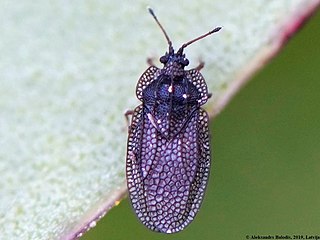 W
WAcalypta is a genus of lace bugs in the family Tingidae. There are at least 50 described species in Acalypta.
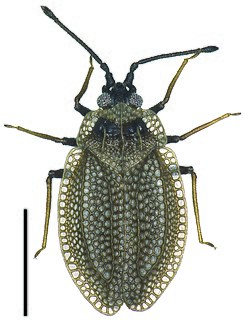 W
WAcalypta marginata is a species of lace bug in the family Tingidae. It is found throughout the Palearctic and in three eastern Asian countries: Japan, Korea and Mongolia.
 W
WAcalypta parvula is a species of lace bug in the family Tingidae. It is found in Africa, Europe and Northern Asia, and North America.
 W
WCopium is a genus of lace bugs in the family Tingidae. There are about 12 described species in Copium.
 W
WCorythucha is a large genus of lace bug in the family Tingidae that is primarily distributed in the New World, especially North America. The genus includes pest species such as the “cotton or bean lace bug" as well as species that provide maternal care, such as C. hewitti (Drake)
 W
WCorythucha arcuata, the oak lace bug is a species of lace bug Tingidae that is a pest of oaks in the Old World. It is native to the New world, and was first observed in Europe in 2000.
 W
WCorythucha ciliata, the sycamore lace bug, is a species of lace bug in the family Tingidae that is associated with sycamore trees.
 W
WCorythucha gossypii, the cotton lace bug or bean lace bug, is a species of lace bug in the family Tingidae that is associated with cotton and a number of other host plants.
 W
WCorythucha marmorata, the chrysanthemum lace bug, is a species of lace bug in the family Tingidae. It is found in Central America and North America.
 W
WDerephysia is a genus of lace bugs in the family Tingidae. There are more than 20 described species in Derephysia.
 W
WDerephysia foliacea, the foliaceous lace bug, is a species of lace bug in the family Tingidae. It is found in Africa, Europe and Northern Asia, and Southern Asia.
 W
WDictyla is a genus of lace bugs in the family Tingidae. There are at least 80 described species in Dictyla.
 W
WDictyla echii is a species of lace bug in the family Tingidae. It is found in Africa, Europe and Northern Asia, North America, and Southern Asia.
 W
WDictyonota is a genus of lace bugs in the family Tingidae. There are more than 60 described species in Dictyonota.
 W
WGaleatus is a genus of lace bugs in the family Tingidae. There are about 18 described species in Galeatus.
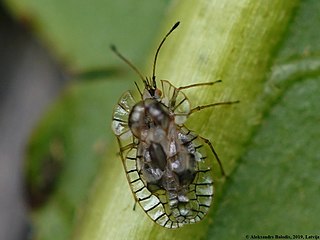 W
WGaleatus affinis is a species of lace bug in the family Tingidae. It is found in Europe and Northern Asia, North America, and Southern Asia.
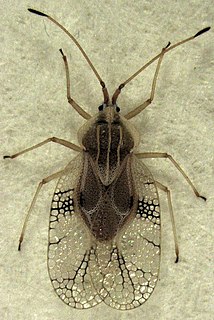 W
WGargaphia is a genus of lace bugs in the family Tingidae. There are more than 70 described species in Gargaphia.
 W
WGargaphia solani is a subsocial species of lace bug commonly known as the eggplant lace bug. The species was described by Heidemann in 1914 after it aroused attention a year earlier in the United States as an eggplant pest around Norfolk, Virginia. Fink found that the species became an agricultural pest when eggplant is planted on a large scale.
 W
WKalama is a genus of lace bugs in the family Tingidae. There are at least 30 described species in Kalama.
 W
WKalama tricornis, the gorse lacebug, is a species of lace bug in the family Tingidae.
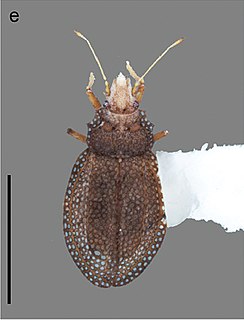 W
WMinitingis is a genus of lace bugs in the family Tingidae. There are at least two described species in Minitingis.
 W
WMinitingis minusculus is a species of lace bug in the family Tingidae.
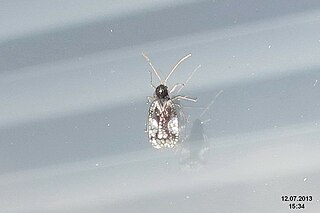 W
WStephanitis is a genus of lace bugs in the family Tingidae. There are at least 90 described species in Stephanitis.
 W
WStephanitis pyrioides, the azalea lace bug, is a species of lace bug in the family Tingidae. It is found in Africa, Australia, Europe and Northern Asia, North America, Oceania, South America, and Southern Asia.
 W
WThe andromeda lace bug is a pest insect on plants of the genus Pieris, especially Pieris japonica, the Japanese andromeda. It originated in Japan with its host plant but has since been introduced to other areas of the globe. At least one Pieris species, Pieris floribunda, is resistant to the bug.
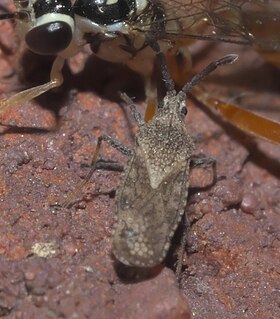 W
WTeleonemia is a genus of lace bugs in the family Tingidae. There are at least 80 described species in Teleonemia.
 W
WTeleonemia nigrina is a species of lace bug in the family Tingidae. It is found in Central America and North America.
 W
WTeleonemia scrupulosa, the lantana lace bug, is a species of lace bug in the family Tingidae. It is found in Africa, Australia, the Caribbean, Central America, North America, Oceania, South America, and Southern Asia.
 W
WThe Tinginae are a subfamily of lace bugs. Three tribes were included in Froeschner's analysis.
 W
WTingini is a tribe of lace bugs in the family Tingidae. There are at least 250 genera and 2,400 described species in Tingini.
 W
WTingis is a genus of lace bugs in the family Tingidae. There are at least 130 described species in Tingis.
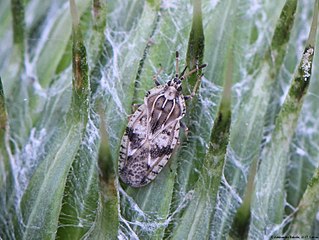 W
WTingis cardui is a Palearctic lacewing bug. The species is widespread in almost all of Europe and lacking only in the far North. It is common also in North Africa and East Asia minor and the Middle East as well as southern Russia and the Caucasus to Siberia and the North of China. Tingis cardui lives on Cirsium, in particular on Cirsium vulgare, but also on Cirsium palustre and less frequently on Carduus nutans, Carduus crispus, and Carduus acanthoides. Overwintering occurs as an imago in the ground litter, or under loose bark. The bugs appear in April or May, and sit on the basal leaves of their food crops.